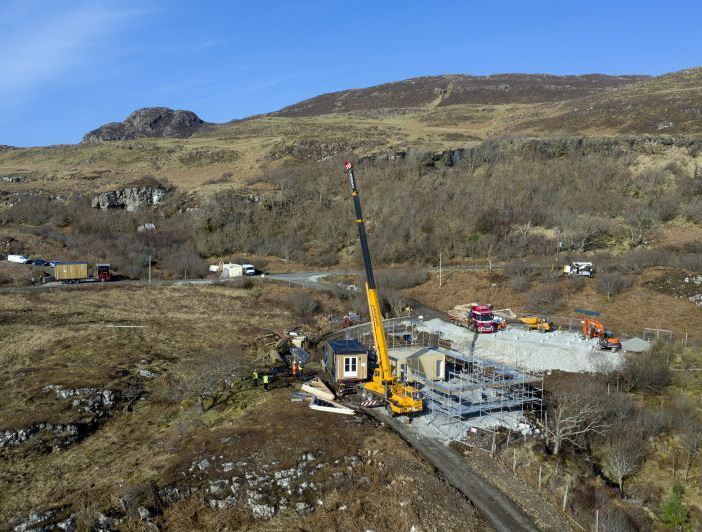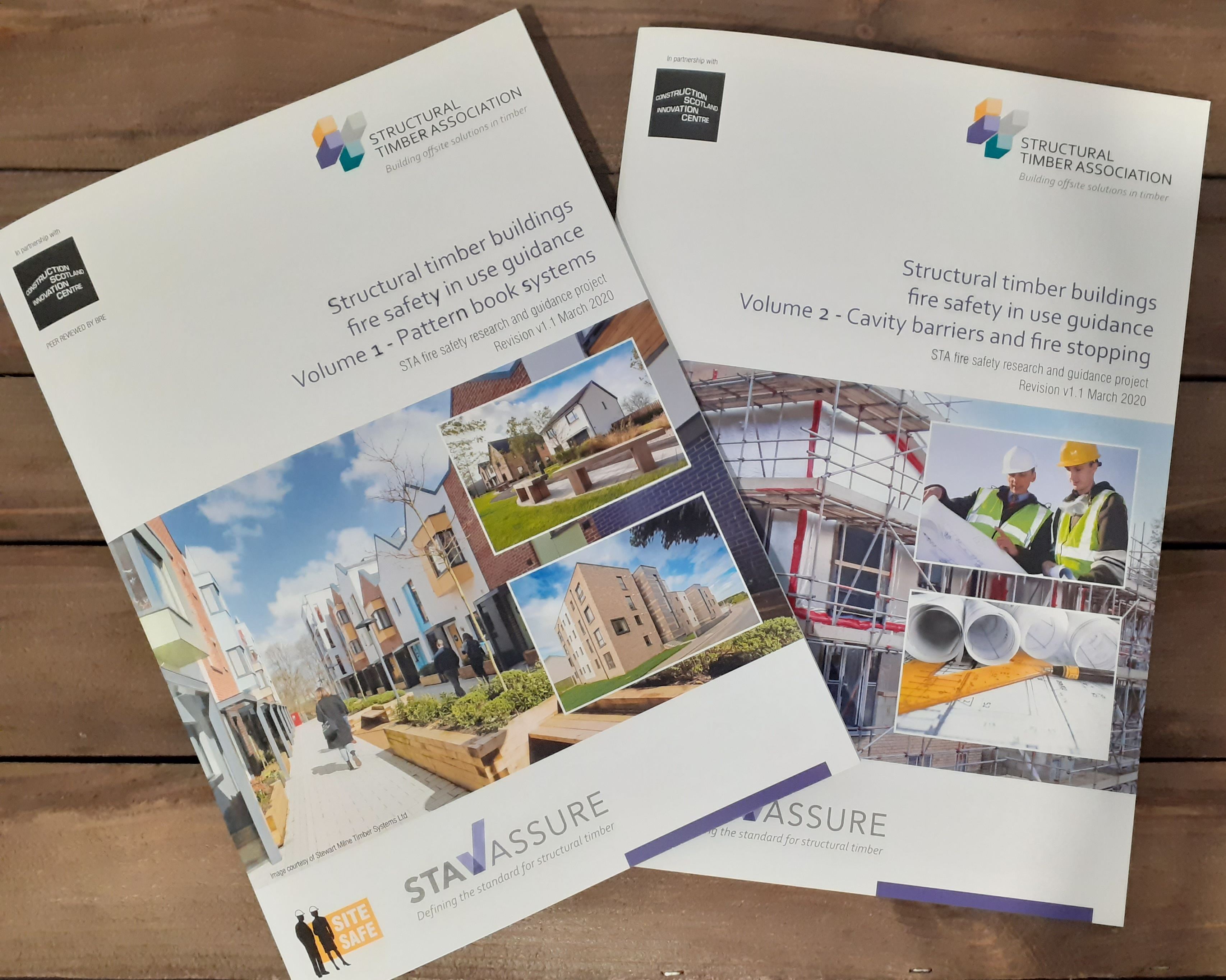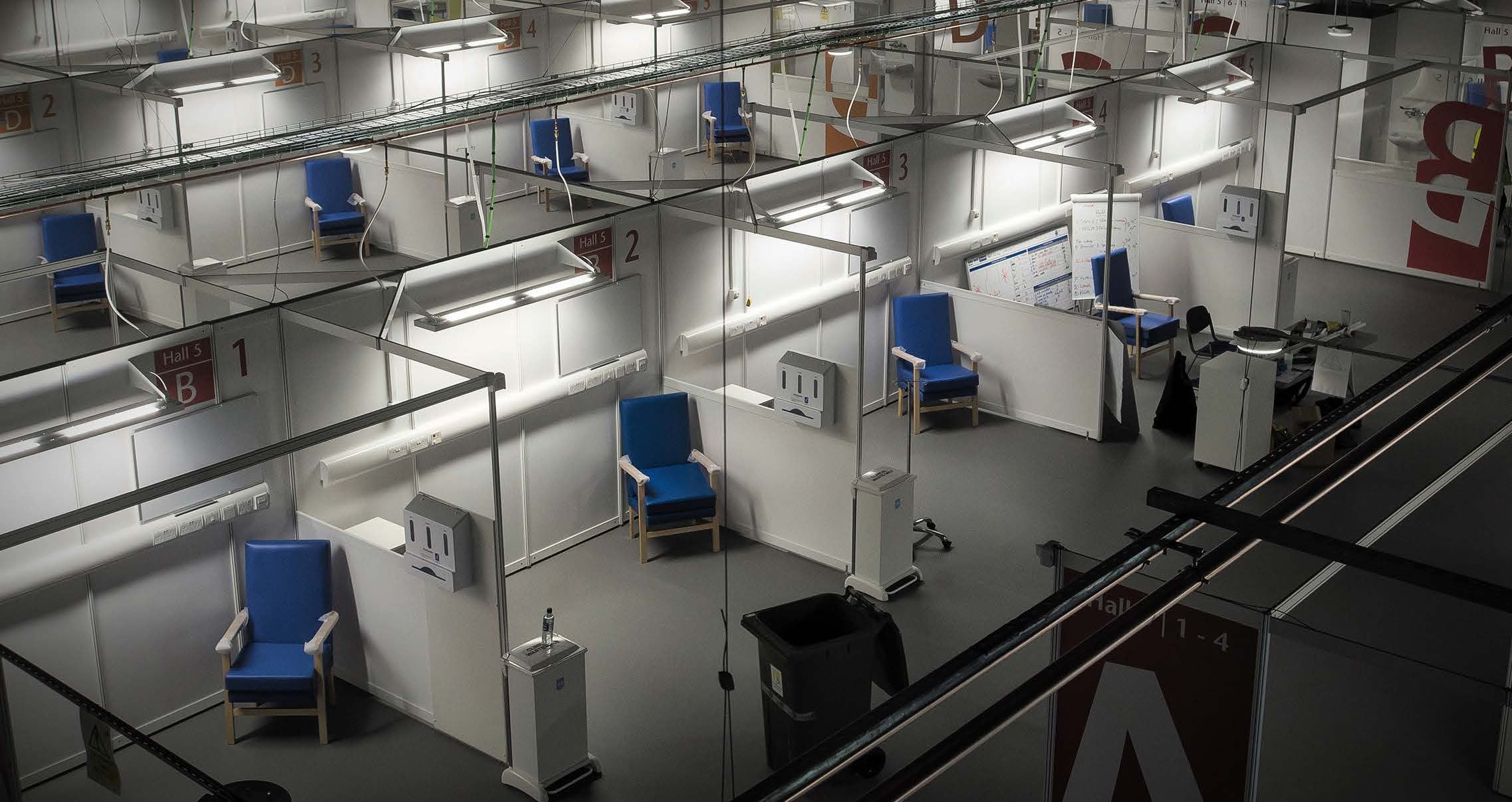Content
Masters' fund projects: 20-21
Case studies from the work our students do through the Built Environment Innovation Masters Fund



Aivars Zogla, Edinburgh Napier University: Architectural Technology & Building Performance
Project
Working with CALA Homes, Aivars’ project investigated and reported on the embodied carbon benefits of Scottish / UK’s and European Cross Laminated Timber (CLT) panels as low- carbon alternative to load bearing masonry, reinforced concrete, steel and timber frame structures for residential low-rise buildings in Scotland, UK. Life Cycle Assessment (LCA) Cradle to Gate with optional A4 module was used to estimate the environmental impact and quantify carbon footprint of 6 construction scenarios.
Aivars found Scottish CLT and ‘Timber frame’ had the lowest EC amount with the saving potential ranging between 58 and 101tCO2e per whole building when compared with other 3 scenario average - a 73 to 328% improvement. The highest result is achieved with timber product sequestration (TPS). CLT with TPS on average can achieve 126 tCO2e or 359% improvement per building compared with load bearing masonry, reinforced concrete frame and steel frame.
Innovation
The use of CLT in construction projects is innovative, as the industry is yet adapting to fully utilize this material. The material itself is also being developed further, as recently a lot of research has been done to understand its manufacturing potential, use and the prospective introduction of hybrid systems.
Benefit
Net-zero energy and net-zero carbon buildings are at the forefront of the government’s agenda and it’s directly related to the public’s expectations when purchasing a new home. New building regulations, guidelines and policies are getting introduced and companies need to adapt in order to provide the same quality of their services and products by still maintaining their commercial viability.
This project provides a basis in form of research and case study for Scottish and British house builders and real estate developers to adapt new low environmental impact structural materials as an alternative to traditional ones. Specifically – domestically manufactured Cross Laminated Timber (CLT) panels from homegrown timber as an alternative material to traditional ones for residential buildings in Scotland / UK in terms of reducing embodied carbon and therefore supporting transition to Net Zero carbon built environment by 2050.
From a wider perspective – it supports the need to advance the Scottish and the UK construction sectors manufacturing by developing new locally produced mass timber products. This would contribute to the UK’s Ten Point Plan for a Green Industrial Revolution that puts greener buildings at the heart of green economic recovery and plans to support 50000 jobs and promote building new supply chains and factories in the UK. Aivars’ project fed into CSIC’s wider homegrown mass timber projects, who have manufactured the UK’s first full-scale, homegrown CLT panels and first Scottish-sourced CLT and NLT housing unit which was showcased at this year’s COP26 United Nations conference on climate change.
Partners
Edinburgh Napier University, CALA Homes, BE-ST
Calum Boath, University of Dundee: MSc Sustainability and Renewable Energy
Project
A key sector which has been identified as crucial for addressing climate change issues is the construction industry. The UK government is continually forming and renewing greenhouse gas (GHG) emission budgets. The construction industry is a considerable contributor of CO2 emissions in the UK. This project report analysed the framework of sustainable construction and in particular the role of modern methods of construction. Through literature review and interviews with professionals involved in the management and consultancy of construction works, it is possible to determine the management strategies that have an influence on sustainability- related targets and identify barriers that are currently stopping low carbon construction from being implemented successfully, and further outline how the construction industry can move towards carbon net zero and sustainable design.
Innovation
This project is fundamental for the construction sector as the issue of sustainability and low carbon construction in the UK industry is now a matter of legal obligation that will affect every aspect of the built environment. This study aims to investigate modern methods of construction from a housebuilders perspective and build a production model for my industry partner CALA Homes that is broadly transferable across the UK’s construction industry.
Benefit
This project provided a sustainable production model for construction businesses. It can be transferred across the wider Scottish construction market to provide low carbon solutions to developing homes.
Partners
University of Dundee, CALA Homes, BE-ST
Conor Owen, University of Dundee: MSc Civil Engineering
Project
This project looked at improved assessment and upgrading of overhead line foundations for electricity pylons. Assessment, renewal and upgrade are required due to increased load on the system from renewable energy generation in remote areas that require grid connection. This results in upgrading of conductors to carry additional load. It is necessary to assess the foundations to see if they can carry the additional loading. Current assessment procedures are judged as conservative resulting in unnecessary spend, construction and environmental impact. This project investigated improved approaches to existing foundation assessment, design, construction and low carbon upgrade strategies.
Innovation
The innovation in the project comes from the utilisation of new advanced software techniques to study an old problem. This was undertaken using University of Dundee specialist expertise in this area. Several techniques were investigated with a view to transferring some of this knowledge to SSEN such that they can undertake their own design and development in-house. This could lead to better more efficient design and construction of OLE foundations in the UK and any new approaches developed may be of interest globally.
Benefit
There is potential for step change in the SSEN/ SHET approach to OHL foundation design and assessment that can have wider implications for OHL operators and other foundation applications across the geotechnical sector. There is significant demonstrable potential for cost saving and reduction in CO2 output in the short term SSEN/SHET upgrade portfolio.
Partners
University of Dundee, SSE, BE-ST
David McGall, Heriot Watt University: MSc Civil Engineering
Project
Construction projects often over use imported fills which increase costs and cause a negative environmental impact by disposing of site material and importing quarried stone or concrete. I will re-run the analysis of previous Maccaferri jobs which utilise importing fill material to determine if using site won material through various methods (sieve testing, soil nailing, lime stabilised fill etc.) is possible and has a cost/benefit analysis over traditional methods to see if it should be used on a wider scale.
Innovation
The project will utilise less common design methods which are more environmentally friendly (for example using soil nails with Gabions) to significantly reduce imported fills. This could save time and money and also reduce the environmental impact on the project. Maccaferri are a large company with a significant presence in Scotland. Hopefully by proving that site won material can be utilised better, it becomes a more common practise in the company throughout the country.
Benefit
Hopefully this project will encourage the use of sustainability in the construction sector by providing a direct benefit to the Client through cost/ time savings. Perhaps questioning the use of imported fills, more companies will decide this may not be the most efficient method.
Partners
Heriot Watt University, Maccaferri, BE-ST
Fionnghal Caldwell, Edinburgh Napier University: MSc Architectural Technology and Building Performance
Project
Understanding different methodologies of achieving net zero carbon within Scottish housing.
Working with Carbon Futures, Fionnghal’s research is comparing different interventions that can be applied in Scottish new build housing and analysing them in terms of effectiveness at reducing emissions. By analysing a baseline house within a 3D building simulation software, Fionnghal will gain data on the most effective solutions for achieving net zero carbon emissions within a standard housing type.
Innovation
There is very little research analysing different methods of achieving net zero in Scottish housing. This research could serve as guidance into the best ways of integrating net zero into designs.
Benefits
The benefits of this research to the wider construction industry are:
- identifying the best strategies for achieving net zero carbon emissions
- how best to achieve them
- how to design them into a project
- helping increase wider knowledge on net zero housing in Scotland
Partners
Carbon Futures, Edinburgh Napier University, BE-ST
Franklin Chile Emina, Edinburgh Napier University: MSc Environmental Management
Project
The built environment accounts for 45% of total UK carbon emissions (27% from domestic buildings and 18% from non-domestic buildings). In order to meet the aspiring net zero emissions 2050 target set out by the UK government, the built industry has to set out measures to decarbonise its built processes.
Franklin's research primarily focuses on investigating and reporting on how the decarbonisation of infrastructure play’s a key role in the drive towards net zero, particularly for the operational carbon reduction within new build homes. This project reviewed key renewable technologies, from generation/impact assessments of the technologies (EV charging, PV Panels, Heat Pumps), and efficiency in terms of the impact to the electrical network. This provided a detailed understanding of the options available and a recommendation based on cost, efficiency and legislative compliance.
Innovation
Presently a lot of developers are implementing energy appliances that are fossil fuel dependent in their new builds, resulting in the emission of GHG. This project offers an insight into the available renewable technologies, how it could be integrated in their built practices and the potential benefits e.g. offering technical solutions to the reduction of CO2 emissions during the design stages of buildings.
Benefit
The provision of detailed understanding of the renewable technology options and application, its benefits from a decarbonisation perspective, reduction in energy cost for home occupants and ensuring compliance with legislation.
Partners
Glasgow Caledonian University, CALA Homes, BE-ST
Fraser McCulloch, Robert Gordon University: MSc Advanced Architectural Design
Project
The demand for housing in the UK has been increasing over the years but the demand for social housing has been even greater.
While we are starting to build more housing including social and low-cost, we need to build 1.2 million homes to meet the current demand for housing in the UK A shortage of skilled labourers has also affected the demand for housing and there needs to be a solution to meet the demand if the number of skilled labourers continues to decrease.
The project developed and evaluated novel generative design systems of prefabrication that produce novel solutions for housing. Advanced algorithmic design and close coupling with both the CLT supply chain and the needs of housing providers will be used as methods to advance the state of the art in design for pre-fabrication. The goal of the project was to produce designs that are easy to fabricate with very little additional processes in a “file to factory” setting.
Innovation
Generative systems and prefabrication have a novelty potential in solving bottlenecks in the design and manufacture process, if coupled with demand led briefs and the supply chain. The generative system that Roubo is developing will allow for the mass-customisation of housing using CLT, in a process that is totally new for Scotland, the UK and the European market.
Benefit
The project employed novel algorithmic and digital process in the design of houses to eliminate bottlenecks in the production. The Scottish construction market will benefit by having access to a mass-customisation platform that will radically improve production processes.
The methods of both quantitative and qualitative can be used to gain knowledge and understanding of certain issues that might not have been recorded before.
Partners
Robert Gordon University, Glulam Solutions, BE-ST
Greg Bailey, Edinburgh Napier University: MSc Construction Project Management
Project
Carbon Net Zero and sustainable design is at the fore front of the government’s agenda and in the public’s expectations when purchasing a new home. The construction industry is a large contributor to greenhouse gas emissions and finding a more sustainable solution is a primary goal for construction companies.
Modern methods of construction and new technology such as Building Information Modelling (BIM) are considered to have an important role to play in improving the performance of the construction industry; to deliver more energy efficient and sustainable buildings, more quickly and cost effectively whilst reducing waste. An investigation into the benefits of changing traditional construction methods to modern methods of construction (MMC) involving offsite prefabrication of standardised elements such as SIP panels and closed timber frame construction could reveal a more sustainable approach to modern construction today.
BIM has the potential to provide a platform for collaborative working that can consider the whole supply chain and facilitate a more integrated design and construction process. BIM should have a key part to play in implementing MMC in a mass market. It should provide the opportunity to examine the pre-fabrication of components/ systems offsite using different materials, review assembly sequences, optimise design/cost, reduce waste, perform energy assessments of different house designs as well as providing customers with virtual tours of their future homes. MMC in conjunction with BIM is likely to be key to the implementation of a wider offsite manufacturing strategy and the successful delivery of high-performing, long-lasting and good-looking homes that fully meet the expectations of their occupants.
Innovation
Although a significant amount of research has been carried out considering the use of BIM in the construction industry, limited research has been undertaken examining the use of MMC in conjunction with BIM for building homes.
MMC in conjunction with BIM is likely to be key to the implementation of a wider offsite manufacturing strategy and the successful delivery of high-performing, long-lasting and good-looking homes that fully meet the expectations of their occupants.
Benefit
The benefit of this analysis is to provide a broad and detailed analysis of MMC in the marketplace with a proposal to either one or several production models that can be embedded within a business with the use of BIM to assist in the successful delivery of approximately 2,500 homes every year.
Partners
Edinburgh Napier University, CALA Homes, BE-ST
Jack Cleary, University of Dundee: MSc Civil Engineering
Project
The industry partner has previously undertaken research to create labour coefficients in the United Kingdom, allowing accurate labour demands to be determined for varying projects. The overall aim of this research is to determine labour coefficients that can be used in European countries. To this end, I will analyize data from European statistical databases regarding the construction sectors for each of the chosen European countries together with the employment and labour data for these countries.
Innovation
This research project is pioneering as this type of research into labour forecasting has never been undertaken in an European country before. Making this project a commercial innovation for any future projects that wish to be undertaking in the European Union as this will offer unique information (labour coefficients) that cannot be easily sourced elsewhere.
Benefit
This project will provide Whole Life Consultant with a unique advantage over their competitors as they will be able to offer a labour forecasting service to clients interested in estimating labour demand for future EU-based projects. Although this will not directly affect the Scottish construction industry, the increase in business for WLC Ltd will greatly contribute to the Scottish economy.
Partners
University of Dundee, Whole Life Consultants, BE-ST
Killian Galvin, Edinburgh Napier University: MSc Construction Project Management
Project
Challenges are hindering the performance of construction projects in relation to delivery on time, to the required budget while meeting set quality standards.
In conjunction with these, particular challenges which are hindering progression include the lack of traditional site labour, the ineffective management of materials on site, soaring health and safety standards and poor quality standards being achieved.
The outcome of this research project is to develop a greater understanding, consideration and appreciation of how modular building as a branch of modern methods of construction (MMC) can play a game-changing role in transforming the construction industry by means of providing assistance to the construction industry in reducing many traditional construction project challenges.
Gaining a greater insight into the predictability and productive efficiencies the modular building industry inherently provides in areas of workforce, material, quality and health and safety management will be the focus of this research, through realisation of today’s traditional construction industry challenges in these areas. Further to this, the research will also look into how possible, new pioneering technologies within the modular building environment can assist in promoting the attractiveness and driving use of the modular building systems in construction projects into the future.
Innovation
This project represents many new, pioneering innovative technical and commercial attributes, of which mainly include:
- Self designed progress flow charts
- Use of software such as BIM
- Emphasis on modular workforce predictability and productivity in the controlled working environment
Benefit
Benefits to be gained to the wider Scottish construction market include:
- Increased ease in the role of the Project Manager on site through the incorporation of modular systems
- Influence the realisation of the supply and demand of skilled workforce, the need for increased training initiatives, apprenticeship programmes
- Greater understanding of the true, maintained positive health and safety environment the modular factory provides
- Benefits to the construction industry as a whole, including councils and developers, in greater understanding of a Quality Assurance and Quality Control system
Testimonial
“We’re just about to announce and start work on the largest modular affordable housing project in Scotland. It will be great for Killian to come on this journey with us, gaining a great insight to the different elements of the development and using this for his research project”
- Wee House Company
Partners
Edinburgh Napier University, Wee House Company, BE-ST
Natalie Bushell, Glasgow Caledonian University: MSc Environmental Management
Project
The Scottish slate industry used to be world- leading, with slate quarries at their peak in 1896 producing some 45,000 tonnes (45 million slates).
By 1910 this output almost halved. By the 1960s all Scottish quarries had closed. Now concrete tiles or imported slates are increasingly used for replacements or repairs.
Natalie, a Traditional Building Materials trainee and Geology graduate, gained a strong interest in this forgotten industry. The project initially arose from working with Historic Environment Scotland and looked to research the environmental benefits and costs of re-roofing Scottish traditional buildings (and roofing new builds) in slate and comparing this to the alternative products over the lifetime of the building. GIS was used to identify and quantify the amount of Scottish slate roofs to estimate the amount of slate that would be required for eventual repairs.
The project also compared the carbon footprint of imported slate to slate that could be sourced from old Scottish slate quarries, which would support the environmental case for Historic Environment Scotland to reestablish and research solutions to make a renewed Scottish slate industry more environmentally friendly and desirable.
Innovation
The Scottish slate industry shut down over 60 years ago so there is currently no supply of new Scottish slate tiles and therefore repairing projects must be carried out with recycled slate (which may not last as long since they may already be around 100 years old) or imported slate from England, Wales, Spain, or even further away.
Although the carbon footprint of different roofing materials has already been quantified, the environmental costs of importing slate has not yet been researched in detail, yet it is of increasing importance to Scotland since there are no local slate quarries left and our traditional buildings continue to get older.
Natural slate has a much longer lifespan than that of modern roofing materials. This piece of work will look at the carbon saved over the lifetime of the building from taking into account the processing and transportation of the material and seek to quantify how much carbon could potentially be saved by utilising local natural slate.
Benefit
It is hoped that this work will help facilitate a move towards a more circular economy in the construction sector in regards to roofing materials and help in highlighting the benefits of Historic Environment Scotland’s work in trying to establish a new Scottish slate industry.
The climate emergency has made the industry more aware of where things come from and how they are made. There is an economic, environmental, and ethical argument to using locally sourced natural stone as a roofing material, however this has never been quantified in terms of the potential carbon saved.
The construction sector is focused on initial costs as opposed to durability and often cheaper, less durable materials that are cheaper to build are utilised in favour of more robust materials that would long outlast modern construction materials.
By researching the environmental benefits of using slate as a roofing material it is hoped this information can be used so that slate might be chosen at the design stage and help construction projects meet environmental requirements.
Partners
Glasgow Caledonian University, Historic Environment Scotland, BE-ST
Nicole Woodward Borresen, Edinburgh Napier University: MSc Advanced Materials Engineering
Project
Nicole conducted a material selection analysis on the bottle neck and cap on her industry partner’s zero plastic biodegradable paper bottle. The project included a comparison between various bio-based and biodegradable polymers, including the material currently used for the bottle neck/cap, tin. The research included the manufacturing processes and cost, functional requirements, material properties, geometric requirements, and environmental cost. It also considered the ease of manufacturing and compatibility to the paper bottle it is attached to. This includes the time for the materials to biodegrade, comparing it to the paper bottle.
Innovation
The use of non-biodegradable polymers in packaging have become an issue for consumers seeking more environmentally friendly products. The worldwide built and natural environment is littered with plastic bottles and finding an alternative to this material could curb waste and pollution throughout both. Investigating the possibilities of the biodegradable polymers that are currently offered and possible options in the near future can be a solution to non-biodegrabable packaging currently used.
Benefit
This project will provide possibilities for bottlecaps and necks to become more eco friendly, and it will give an understanding of the impact on the environment of these various materials.
Partners
Edinburgh Napier University, CHOOSE, BE-ST
Scott McKirdy, University of the West of Scotland: MSc Civil Engineering
Project
With reality capture technologies such as VR or AR having provided greater efficiencies in construction, and the new generation of workforce having grown up in the digital age, it poses the question of how to best capture the transformation into its next iteration and in particular explore the possibilities of reality capture technologies in the application of health and safety.
After an extensive literature review, Scott undertook a qualitative research approach in the form of semi structured interviews of industry professionals alongside his industry partner: Balfour Beatty. Through this, Scott gained the opportunity to interview real on site operatives. The interviews sought to explore establish current health and safety practices and to what extent reality capture technologies is applied, gather reactions and identify themes and areas that will add value to future approaches towards health and safety in the industry.
Innovation
The research analysed reality capture technologies which have only partly been explored and not yet reached their full potential. This study sought to find new conclusions that will lead to new practices that can benefit both the Scottish and the wider construction industry.
Benefit
The conclusions drawn from this project could improve both training and workplace practices. VR/AR can better prepare workers to perform high-risk manoeuvres on site. It can also allow operatives to avoid site entirely through remote inspection. Scott’s analysis highlights an innovative opportunity to promote both digitalisation and wellbeing while also providing real data on the future landscape of this area.
Partners
Edinburgh Napier University, Balfour Beatty, BE-ST
Sharon-lee Bow, University of Stirling: MSc Housing Studies
Project
Prospect are a RSL but are having to diversify into providing MMR properties in order to keep funding the service they provide due to cuts to social housing budgets etc. The research will look at how sustainable this is in comparison to their traditional model of 100% social housing for their business and the community of Wester Hailes (where all their properties are based) to determine the economic and social impact of this, and if it will lead to a more sustainable community.
Benefit
For the project partner, this project should provide a thorough analysis of their plans and help anticipate any issues of sustainability (or lack thereof) in both their business and community. For the construction market, it will offer analysis of build to rent properties (MMR), how sustainable these are and which areas they should be constructed in order to produce the most amount of benefits for the communities and society.
Partners
University of Stirling, Prospect Community Housing, BE-ST
Thomas Franzén Storm, Robert Gordon University: Advanced Architectural Design
Project
Working with Glulam Solutions, Scotland’s only timber engineering contractor supplying sustainable glulam, CLT and advanced panel systems, Thomas examined the life cycle of Glulam engineered timber products from forestry to installation on-site including growth period, harvesting, processing, transport to UK sites and then site installation. He compared this with a homegrown alternative but also with steel and concrete build methods. Additionally, Thomas examined the benefits of DfMA and disassembly in the engineered timber life-cycle.
Innovation
The project attempted to establish the carbon sequestration of key projects of Glulam Solutions as a whole lifecycle analysis, comparing it with other technologies and homegrown timber supply chains. This provided benchmark models for comparable studies but also for a circular economy of components. Thomas also tied in blockchain and smart technologies into his model circular econonmy - the potential to use blockchain technologies in construction has rarely, if ever, been done before.
Benefit
The project provided benchmark models for carbon sequestration, and regulating computation, along with a model circular economy based on blockchain and smart contracts.
Partners
Robert Gordon University, Glulam Solutions, BE-ST
Victor Henquel, Edinburgh Napier University: MSc Advanced Structural Engineering
Project
Following Victor’s honours project dissertation - an environmental comparative study between different timber modern methods of construction in a BIM environment - Victor extended this research topic and area for his MSc dissertation. As part of his work as a research assistant in the Centre for Offsite Construction + Innovative Structures at Edinburgh Napier University, Victor developed a digitisation methodology for a standard house type using BIM to incorporate information and demonstrate the economic and environmental impact of utilising homegrown timber. This fed into a part of Scottish Forestry’s home grown demonstrator project, which delivered a decision making tool capable of determining the embodied energy and embodied carbon of both imported and homegrown timber frame build ups. This tool allows designers to quantify the environmental impact of their designs and offers alternative, more environmentally friendly product choices to reduce the embodied carbon for the whole life cycle of the project.
Innovation
Offsite Solutions Scotland are a consortium of timber offsite manufacturers. The vast majority of timber utilised by these organisations is imported. This project acted as a demonstrator of the benefits of using locally sourced timber to these organisations, who would be among the first in the UK to do so.
Benefit
With timber being a prominent building material, and much of that timber being imported, the associated emissions with transport of imported goods can have a significant impact on the sectors carbon footprint. This can outweigh the associated operational carbon emissions of low energy new build and energy retrofit projects. This research was conducted to improve the overall carbon credentials as well as to have wider social and economic impact. Victor took part in a webinar alongside CSIC in September 2021, helping spread the word of this tool to the industry.
Partners
Edinburgh Napier University, Offsite Solutions Scotland, BE-ST



